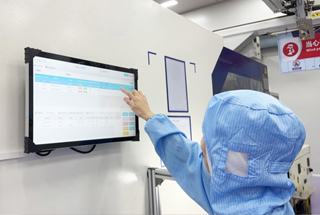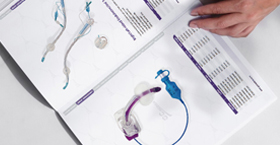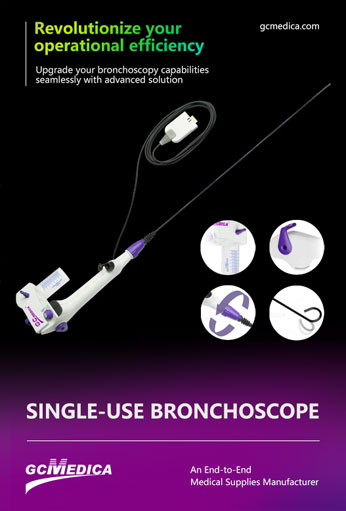Disposable bronchoscopes are designed for single‑patient use, combining ease of deployment with reliable performance across a variety of clinical scenarios. One of the most critical specifications when selecting a disposable bronchoscope is its size—particularly the outer diameter, working‑channel diameter, insertion‑tube length, and tip deflection capabilities. These dimensions influence maneuverability within the airway, the types of instruments that can be passed through the scope, and overall procedural efficiency. Below, we explore the key size parameters of disposable bronchoscopes in tabular form, followed by an overview of how these dimensions impact clinical use.
Disposable bronchoscopes generally fall into two broad categories based on outer diameter: pediatric/neonatal and adult scopes. Pediatric scopes typically range from 2.8 mm to 3.6 mm outer diameter, allowing safe navigation of smaller airways, while adult scopes range from 4.0 mm to 6.0 mm, providing improved suction and accessory compatibility. Working‑channel diameters vary correspondingly, from approximately 1.2 mm in the smallest pediatric scopes up to 2.8 mm or more in larger adult devices. Longer insertion‑tube lengths (up to 600 mm) facilitate deep lung access for sampling or drainage, whereas shorter tubes (around 300–400 mm) are optimized for upper airway evaluation.
Tip deflection—measured in degrees of upward and downward bending—affects the operator’s ability to navigate bifurcations and visualize subsegmental bronchi. Typical disposable bronchoscope tips offer around 120°–180° of upward deflection and 120°–160° of downward deflection. These angles allow clinicians to reach difficult angles without excessive torque on the tracheal wall. Field‑of‑view (FOV) and depth‑of‑field (DOF) are also influenced by scope diameter and distal optics, but those parameters are more a function of the imaging system than of size alone.
| Parameter | Pediatric Scope Range | Adult Scope Range | Clinical Implications |
|---|---|---|---|
| Outer Diameter (OD) | 2.8 mm – 3.6 mm | 4.0 mm – 6.0 mm | Smaller ODs reduce trauma in narrow airways; larger ODs allow better suction and accessory use |
| Working Channel Diameter | 1.2 mm – 1.7 mm | 2.0 mm – 2.8 mm | Larger channels permit forceps, brushes, and cryoprobes; small channels limit intervention types |
| Insertion‑Tube Length | 300 mm – 450 mm | 500 mm – 600 mm | Longer tubes enable distal sampling (e.g., alveolar lavage); shorter tubes improve handling in proximal airways |
| Tip Deflection (Up/Down) | 120° / 120° | 180° / 160° | Greater deflection angles facilitate navigation into segmental bronchi |
| Field‑of‑View (FOV) | 80° – 100° | 90° – 120° | Wider FOV enhances peripheral visualization; narrower FOV may focus on central structures |
| Depth‑of‑Field (DOF) | 3 mm – 50 mm | 5 mm – 70 mm | Longer DOF aids in seeing both near and far structures without refocusing |
| Total Scope Weight | 50 g – 80 g | 100 g – 150 g | Lighter scopes reduce operator fatigue during prolonged procedures |
Different clinical scenarios demand specific size characteristics. In neonatal and pediatric intensive care, the smallest diameters (OD ≤ 3.0 mm) are essential to prevent mucosal injury, though these scopes carry limited working‑channel options. For outpatient bronchoscopy or interventional pulmonology in adults, larger scopes (OD ≥ 5.0 mm) provide robust suction and broader accessory compatibility, facilitating biopsy, foreign‑body removal, and stent placement. When deep lung interventions—such as bronchoalveolar lavage or distal lesion sampling—are required, clinicians often select longer scopes with high tip‑deflection capability to reach subsegmental bronchi safely.
The size profile of a disposable bronchoscope—encompassing outer diameter, working‑channel diameter, insertion‑tube length, and tip‑deflection angles—is foundational to its clinical utility. Pediatric scopes prioritize minimal invasiveness, while adult scopes balance channel size and maneuverability for complex interventions. Understanding these parameters enables clinicians to tailor device selection to patient age, airway anatomy, and procedural goals, ensuring safe, effective airway visualization and intervention.
| Single Use Flexible Bronchoscopy > |


 Français
Français Español
Español Products
Products

 About Us
About Us












